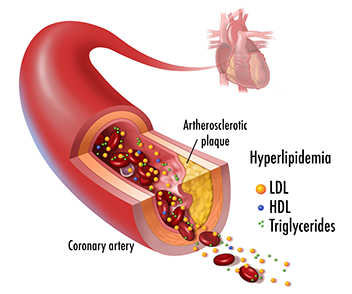Last updated:
Researchers Finetune Genomic Links To High Blood Lipid Levels
Researchers fine-tune genomic links to high blood lipid levels
Identifying gene variants may lead to greater understanding of susceptibility to high cholesterol, cardiovascular disease risk
By Steven Benowitz
Associate Director of Communications, Extramural Research Program
"We hope that a better understanding of the genes and functional gene variants underlying blood lipid levels can help us figure out who might be at risk for high lipid levels, and better identify additional treatment targets," said Kari North, Ph.D., associate professor of epidemiology at the University of North Carolina School of Public Health, and a co-senior author on a paper describing the work that recently appeared in PLoS Genetics. Dr. North and her team were supported by the National Human Genome Research Institute (NHGRI) Population Architecture Using Genetics and Epidemiology (PAGE) program (http://www.genome.gov/27541456/population-architecture-using-genomics-and-epidemiology/).
The investigators linked gene variants in specific chromosomal regions to blood lipid levels. They did this by examining thousands of gene variants in thousands of people of different ancestral backgrounds, focusing on DNA regions previously connected to blood lipid levels.
In several genomic regions, they identified two or more variants that influenced the amounts of low-density lipoprotein (LDL) cholesterol, high-density lipoprotein (HDL) cholesterol or triglycerides in the blood. A person with high LDLs and triglycerides has a much higher risk for developing diseases affecting the cardiovascular system.
Earlier studies by other scientists had identified approximately 100 variants that were suspected to affect blood lipid levels. However, many studies only examined groups from European ancestry. Dr. North, and Karen Mohlke, Ph.D., associate professor of genetics at the University of North Carolina School of Medicine, along with their teams wanted to study ethnically diverse populations in an attempt to understand the total pool of potential candidate genes and genetic variants likely to affect blood lipids.
In the study, investigators sought and analyzed associations, or signals, at 58 previously identified gene locations (called loci) known to be linked to lipid levels in the blood (LDL, HDL and triglycerides). These loci were studied in 6,832 African Americans, 9,449 East Asians and 10,829 Europeans.
In many cases, they found that lipid levels were affected by more than one variant in a particular genomic location. For example, the researchers found two or more signals at 10 locations in African American genomes, and in nine locations in European genomes, meaning at least two variants could be involved. In East Asian subjects' genomes, they saw four locations with multiple signals. Some signals were the same across these various populations, and the investigators were able to narrow the search for the most likely variants affecting lipid levels in the different groups of people. That is, signals that are repeatedly found may indicate variants that are more likely to play a role in influencing blood lipids in all populations.
While the investigators' search for the most influential gene variants is far from finished (Dr. North notes that much remains to be understood about the heritability of lipid traits), the additional signals helped account for a larger amount of variation in lipid levels that can be explained by a person's genes.
As a result, the scientists found an increase (1.3- to 1.8-fold) in the proportion of "phenotypic variation" - differences in lipid levels - that can be explained by genes in these groups, based on having many signals in the same place. Other results were more population-specific; for example, the research team confirmed many strong signals at or near two genes, PCSK9 and APOA5. These data suggest that some individual variants affect lipids only in certain populations, and not in others.
Investigators hope that these findings can help them better understand the underlying mechanisms of how DNA variants lead to changes in gene expression - when and which genes are turned on and off - and what genes do. They may also explain differences in lipid levels in the blood and in disease development.
"When we figure out how all of these underlying genes function, then we'll be closer to understanding the contribution of genetic variation in lipid levels," Dr. Mohlke said. "We haven't figured out which variants are most active; we've just noted that there are more signals than before."
"These results can help us eventually better understand underlying disease susceptibility, and identify those who are at risk for problems with high lipids in the blood," she said. "We can then find better ways to treat them and to develop better prevention methods. Lipids are one of the largest cardiovascular disease risk factors, and an understanding at the molecular level may be important for public health."
Dr. North stressed the importance of studying different populations. "Much of the work to date on the genetics of lipids has been published on European descent populations, with little in ethnically diverse groups, especially in African Americans," she explained. "The goal of the PAGE program is to investigate ancestrally diverse populations to gain a better understanding of how genetic factors influence susceptibility to disease among the populations." Reviewed: May 22, 2013

